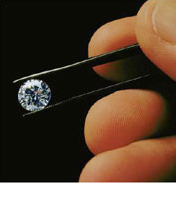Diamonds
Diamond Cutting
Diamond cutting and polishing
In its rough form, a diamond is a lackluster, translucent crystal. Transforming a rough diamond into a
sparkling jewel requires several procedures: cleaving, sawing, bruting, cross working and brillianteering.
Cleaving
Cleaving involves the removal of impurities or irregularities in the rough diamond. Using a second diamond
or a laser, a groove is carved into the diamond along a plane of weakness. A steel blade is placed in the
groove and a sharp blow is delivered which splits the stone. Cleaving requires particular skill; if pressure
is applied to the wrong area or in the wrong direction, the diamond may shatter. Not all rough diamonds
require cleaving or sawing - some diamond rough is well formed and is in ready-to-cut form.
Sawing
Diamond sawing is a twentieth century innovation. Although cleaving may be efficient, it limits the cutter
to shaping the stone according to its natural lines of cleavage. Sometimes, diamonds have to be cut against
a cleavage plane (against the grain). The diamond saw, a lubricated circular steel blade allows cutters to
go against the grain of the diamond without shattering it.
Moreover, the diamond saw allows diamonds to be salvaged from misshaped diamond rough. Sawing is a more
expensive process than cleaving, as it requires about one-tenth of a carat of diamond dust (applied to the
saw with oil) for every carat of sawed diamond. It is also a much slower process than the single-stroke
process of cleaving. It may take days to saw through a two-carat diamond. Extant methods include the use
of lasers to saw through diamonds.
Bruting
The diamond is placed in a lathe with another diamond that is rubbed against it to create the rough
finish of the girdle.
Diamond Polishing
Diamond polishing consists of two phases, crossworking and brillianteering. To give the diamond its finished
look, it is clamped to on an armature above a rotating polishing wheel (scaif). Diamond dust on the wheel's
surface grinds the diamond down to the desired angle. The scaif makes it possible to symmetrically polish all
the facets of the diamond at angles that reflect the most light.
Cross Working
Cross-workers carefully evaluate the clarity of the finished diamond in relation to its final size in
order to obtain the maximum value for the finished stone. The work is performed on a spinning polishing
disc covered with diamond powder. The diamond is held in a clamp and the facets are created one at a time.
Crossworkers polish 18 facets to stringent measurements and angles.
Brillianteering
The function of brillianteers is to create and polish the additional 40 facets to produce a brilliant
cut diamond with 58 facets.






